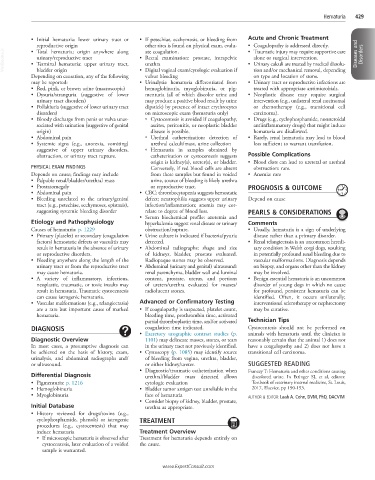Page 883 - Cote clinical veterinary advisor dogs and cats 4th
P. 883
Hematuria 429
• Initial hematuria: lower urinary tract or • If petechiae, ecchymosis, or bleeding from Acute and Chronic Treatment
reproductive origin other sites is found on physical exam, evalu- • Coagulopathy is addressed directly.
VetBooks.ir • Terminal hematuria: upper urinary tract, • Rectal examination: prostate, intrapelvic • Urinary calculi are treated by medical dissolu- Diseases and Disorders
ate coagulation.
• Traumatic injury may require supportive care
• Total hematuria: origin anywhere along
urinary/reproductive tract
alone or surgical intervention.
urethra
bladder origin
vulvar bleeding
on type and location of stone.
Depending on causation, any of the following • Digital vaginal exam/cytologic evaluation if tion and/or mechanical removal, depending
may be reported: • Urinalysis: hematuria differentiated from • Urinary tract or reproductive infections are
• Red, pink, or brown urine (macroscopic) hemoglobinuria, myoglobinuria, or pig- treated with appropriate antimicrobials.
• Dysuria/stranguria (suggestive of lower menturia (all of which discolor urine and • Neoplastic disease may require surgical
urinary tract disorders) may produce a positive blood result by urine intervention (e.g., unilateral renal carcinoma)
• Pollakiuria (suggestive of lower urinary tract dipstick) by presence of intact erythrocytes or chemotherapy (e.g., transitional cell
disorders) on microscopic exam (hematuria only) carcinoma).
• Bloody discharge from penis or vulva unas- ○ Cystocentesis is avoided if coagulopathy, • Drugs (e.g., cyclophosphamide, nonsteroidal
sociated with urination (suggestive of genital ascites, peritonitis, or neoplastic bladder antiinflammatory drugs) that might induce
origin) disease is possible. hematuria are disallowed.
• Abdominal pain ○ Urethral catheterization: detection of • Rarely, renal hematuria may lead to blood
• Systemic signs (e.g., anorexia, vomiting) urethral calculi/mass, urine collection loss sufficient to warrant transfusion.
suggestive of upper urinary disorders, ○ Hematuria in samples obtained by
obstruction, or urinary tract rupture. catheterization or cystocentesis suggests Possible Complications
origin is kidney(s), ureter(s), or bladder. • Blood clots can lead to ureteral or urethral
PHYSICAL EXAM FINDINGS Conversely, if red blood cells are absent obstruction: rare.
Depends on cause; findings may include from these samples but found in voided • Anemia: rare
• Palpable renal/bladder/urethral mass urine, source of bleeding is likely urethra
• Prostatomegaly or reproductive tract. PROGNOSIS & OUTCOME
• Abdominal pain • CBC: thrombocytopenia suggests hemostatic
• Bleeding unrelated to the urinary/genital defect; neutrophilia suggests upper urinary Depend on cause
tract (e.g., petechiae, ecchymoses, epistaxis), infection/inflammation; anemia may cor-
suggesting systemic bleeding disorder relate to degree of blood loss. PEARLS & CONSIDERATIONS
• Serum biochemical profile: azotemia and
Etiology and Pathophysiology hyperkalemia suggest renal disease or urinary Comments
Causes of hematuria: p. 1229 obstruction/rupture. • Usually, hematuria is a sign of underlying
• Primary (platelet) or secondary (coagulation • Urine culture is indicated if bacteria/pyuria disease rather than a primary disorder.
factors) hemostatic defects or vasculitis may detected. • Renal telangiectasia is an uncommon heredi-
result in hematuria in the absence of urinary • Abdominal radiographs: shape and size tary condition in Welsh corgi dogs, resulting
or reproductive disorders. of kidneys, bladder, prostate evaluated. in potentially profound renal bleeding due to
• Bleeding anywhere along the length of the Radiopaque stones may be observed. vascular malformations. Diagnosis depends
urinary tract or from the reproductive tract • Abdominal (urinary and genital) ultrasound: on biopsy, and organs other than the kidney
may cause hematuria. renal parenchyma, bladder wall and luminal may be involved.
• A variety of inflammatory, infectious, content, prostate, uterus, and portions • Benign essential hematuria is an uncommon
neoplastic, traumatic, or toxic insults may of ureters/urethra evaluated for masses/ disorder of young dogs in which no cause
result in hematuria. Traumatic cystocentesis radiolucent stones. for profound, persistent hematuria can be
can cause iatrogenic hematuria. identified. Often, it occurs unilaterally;
• Vascular malformations (e.g., telangiectasia) Advanced or Confirmatory Testing interventional sclerotherapy or nephrectomy
are a rare but important cause of marked • If coagulopathy is suspected, platelet count, may be curative.
hematuria. bleeding time, prothrombin time, activated
partial thromboplastin time, and/or activated Technician Tips
DIAGNOSIS coagulation time indicated. Cystocentesis should not be performed on
• Excretory urographic contrast studies (p. animals with hematuria until the clinician is
Diagnostic Overview 1101) may delineate masses, stones, or tears reasonably certain that the animal 1) does not
In most cases, a presumptive diagnosis can in the urinary tract not previously identified. have a coagulopathy and 2) does not have a
be achieved on the basis of history, exam, • Cystoscopy (p. 1085) may identify source transitional cell carcinoma.
urinalysis, and abdominal radiographs and/ of bleeding from vagina, urethra, bladder,
or ultrasound. or either kidney/ureter. SUGGESTED READING
• Diagnostic/traumatic catheterization when Francey T: Hematuria and other conditions causing
Differential Diagnosis urethral/bladder mass detected allows discolored urine. In Ettinger SJ, et al, editors:
• Pigmenturia: p. 1216 cytologic evaluation Textbook of veterinary internal medicine, St. Louis,
• Hemoglobinuria • Bladder tumor antigen test unreliable in the 2017, Elsevier, pp 190-193.
• Myoglobinuria face of hematuria AUTHOR & EDITOR: Leah A. Cohn, DVM, PhD, DACVIM
• Consider biopsy of kidney, bladder, prostate,
Initial Database urethra as appropriate.
• History reviewed for drugs/toxins (e.g.,
cyclophosphamide, phenols) or iatrogenic TREATMENT
procedures (e.g., cystocentesis) that may
induce hematuria Treatment Overview
○ If microscopic hematuria is observed after Treatment for hematuria depends entirely on
cystocentesis, later evaluation of a voided the cause.
sample is warranted.
www.ExpertConsult.com

